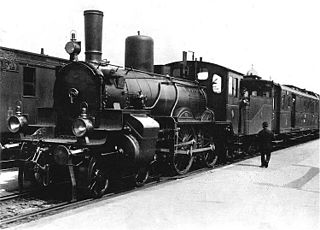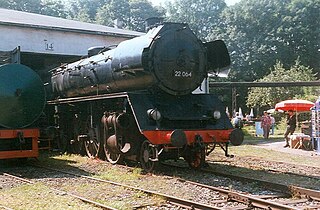
The Deutsche Reichsbahn-Gesellschaft's BR 01 steam locomotives were the first standardised (Einheitsdampflokomotive) steam express passenger locomotives built by the unified German railway system. They were of 4-6-2 "Pacific" wheel arrangement in the Whyte notation, or 2′C1′ h2 in the UIC classification. The idea of standardisation was that it would reduce maintenance costs; i.e. if a BR 01 whose engine shop was in, say, Berlin broke down in Dresden, instead of having to ship the necessary part from Berlin and take the locomotive out of service, a part from the Dresden shop could be used as all of the engines, parts, and workings were exactly the same and produced nationwide. Thus it was a "standard" product for engine shops.

The DRB Class 50 is a German class of 2-10-0 locomotive, built from 1939 as a standard locomotive (Einheitsdampflokomotive) for hauling goods trains. It had one leading axle and five coupled axles and was one of the most successful designs produced for the Deutsche Reichsbahn.

The Prussian Class S 3s were saturated steam locomotives developed by Hanomag for the Prussian state railways and were built from 1893.

The DRB Class 42 was a type of steam locomotive produced for the Deutsche Reichsbahn. It is one of the three main classes of the so-called war locomotives (Kriegslokomotiven), the other two being class 50 and 52.

The Class 44 was a ten-coupled, heavy goods train steam locomotive built for the Deutsche Reichsbahn as a standard steam engine class (Einheitsdampflokomotive). Its sub-class was G 56.20 and it had triple cylinders. It was intended for hauling goods trains of up to 1,200 tonnes on the routes through Germany's hilly regions (Mittelgebirge) and up to 600 tonnes on steep inclines. They were numbered 44 001-44 1989.

The German Class 41 steam locomotives were standard goods train engines (Einheitslokomotiven) operated by the Deutsche Reichsbahn (DRB) and built from 1937 to 1941.

The German DRG Class 02 engines were standard (Einheitslokomotiven) express train locomotives with the Deutsche Reichsbahn-Gesellschaft. Number 02 001 was the first Einheitsdampflokomotive in the DRG to be completed.

The German locomotives of DRG Class 43 were standard goods train engines with the Deutsche Reichsbahn.

The German Class 03.10 engines were standard steam locomotives (Einheitsdampflokomotiven) belonging to the Deutsche Reichsbahn and designed for hauling express trains.

Between 1934 and 1941 the Deutsche Reichsbahn (DRG) converted a total of 691 former Prussian-built Class 55.25–56 steam locomotives; the result was the DRG Class 56.2–8. The carrying axle enabled higher speeds and the engine could even be used as a passenger train locomotive. In addition the average axle load was lower, so that these locomotives could also be used on branch lines. The conversion entailed moving the boiler forward and raising it somewhat. The vehicles were given operating numbers between 56 201 and 56 891, although the numbering was not continuous.

The Prussian G 12 is a 1'E 2-10-0 goods train locomotive built for the Prussian state railways.

The Prussian G 10 was a German goods train, steam locomotive, whose design was based on a combination of the running and valve gear from the Prussian T 16 and the boiler from the Prussian P 8. In developing the G 10, however, the T 16 running gear with side play on the first and fifth axles was modified. The T 16 was also subsequently built with this modified configuration and called the Prussian T 16.1. The G 10 was intended for heavy goods train duties on main lines, but as a result of its low axle load it could be employed more flexibly than its equally powerful cousin, the Prussian G 8.1. The G 10 was occasionally even used in passenger train service.

The steam locomotives of DR Class 23.10, were passenger train engines built for the Deutsche Reichsbahn in East Germany after the Second World War.Is produced in H0 scale to many train model railway.

The DR Class 65.10 was a four-coupled passenger train tank engine operated by the East German Deutsche Reichsbahn (DR) for heavy suburban and commuter services.

The steam locomotives of DR Class 22 were reconstructed passenger train locomotives in service with the Deutsche Reichsbahn in East Germany after the Second World War.
The Prussian G 12.1 was a German steam locomotive built for the Prussian state railways during the First World War and was the largest Prussian freight locomotive with a 2-10-0 wheel arrangement. It had three cylinders, the two outer ones driving the third axle and the inner one the second axle.
The Prussian Class S 10 included all express train locomotives in the Prussian state railways that had a 4-6-0 wheel arrangement. There were four sub-classes: the S 10, S 10.1 and S 10.2.

The Prussian S 4's were German superheated express steam locomotives with the Prussian state railways, later grouped as DRG Class 13.5 in the Deutsche Reichsbahn. They were an evolutionary development of the Prussian S 3. The first locomotive was built in 1898 by Vulcan, Stettin as a modified S 3. She was the first superheated locomotive in the world. She was initially designated as Hannover 74 and towards the end as the S 4 Cassel 401. Two further trials locomotives appeared in 1899 and 1900 as Hannover 86 and Berlin 74 also classed as S 3's. They were later reclassified as S 4's Hannover 401 and Posen 401.
The Prussian G 8.2 class of locomotives actually incorporated two different locomotive types: one was the Prussian/Oldenburg G 8.2, for which the Deutsche Reichsbahn subsequently issued follow-on orders; the other was the G 8.2 of the Lübeck-Büchen Railway.
















